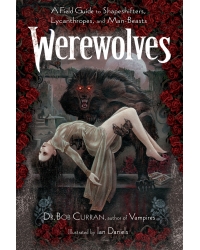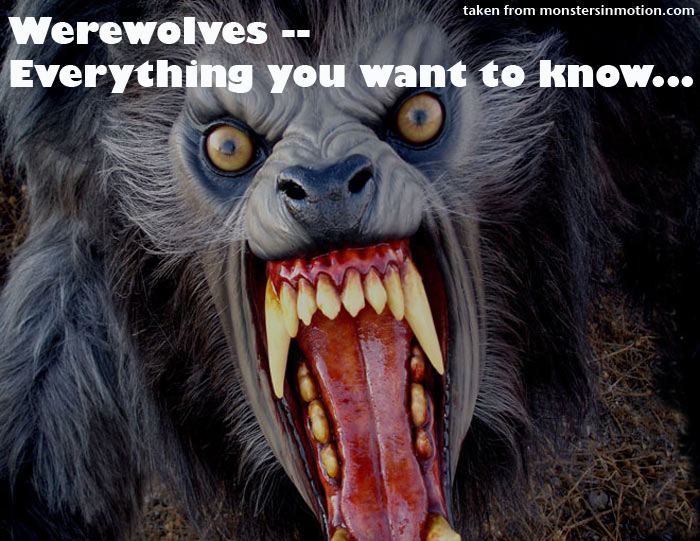 Werewolves --
Everything You Want to Know...
By Dr. Bob Curran
Since earliest times, legends of were-creatures -- humans who could
alternate between their own and animal shape -- have formed a
significant part of our folklore and mythology. One of the best known of
such beings is, arguably, the werewolf. Indeed, it has appeared in medieval legends, in fairy tales and latterly in books and films. It is arguably the wolf
which has dominated the stories and perceptions of the werefolk.
The wolf has been Mankind's oldest adversary. It was with wolves that our early ancestors competed for food and it was against the rivalry of the wolf that they hunted. Arguably, Man has always feared the creature and yet he has always admired its hunting prowess, strength and swiftness. They also
may have envied its hunting prowess and the ease with which it caught its
prey, much more skilfully perhaps than the shambling hominids who were
our forebears. In a world were good hunting was essential for survival of
both the individual and the community, they wished they could be like it.
And so the desire probably took on a form of reality. Our ancestors began to
look for ways in which they could supernaturally be the animal (and not just
wolves, but other animals they admire -- the bull, the horse etc.) and so
acquire these skills. At first, it may have been no more than pretending to be
these creatures -- dressing in skins, adopting certain postures -- but in a world
which was filled with spirits and supernatural forces, an element of possession
by the animal spirit soon became paramount. Shamans and perhaps hunters
themselves were "taken over" by the wolf spirit and began to exhibit lupine
behaviour and possibly perceived lupine attributes. The idea of the man-wolf
had already taken root in the developing human mind. 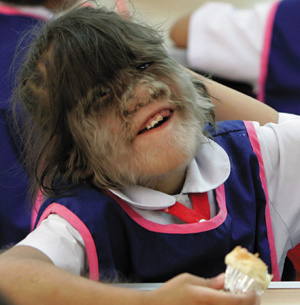 [Left:] Rare condition: Thai schoolgirl Nat Sasuphan is one of some thirty people worldwide living with the rare condition of hypertrichosis. [Left:] Rare condition: Thai schoolgirl Nat Sasuphan is one of some thirty people worldwide living with the rare condition of hypertrichosis.There is no known predilection for ethnicity or gender, although it is thought that of the less than thirty people currently living with the condition, 19 are from one family living in Mexico and the USA.
Werewolf syndrome is associated with the generalised form of hypertrichosis -- excessive hair of the face and body, sparing the palms and soles -- that occurs at birth, and is thought to be caused by rare genetic mutations of two types. One is caused by an abnormality on chromosome 22 and the other is as yet unidentified.
Milder disorders that cause similar hair growth can develop as a side effect of medications such as phenytoin (an anticonvulsant used in the treatment of epilepsy), cyclosporine (an immunosuppressant), diazoxide (a muscle relaxant), and corticosteroids (often used in the treatment of arthritis).
Hypertrichosis is quite different, however, from hirsutism -- a condition that results in male patterns of hair growth in women who produce too much of the male hormones, androgens.
The manifestation of hypertrichosis varies considerably, from mild to severe. Cosmetic management options include bleaching, shaving, depilatory creams, waxing, electrolysis and laser removal. --from Cosmos Online by Rob Moodie
|
That idea persisted down the ages but as civilisations began to consolidate
and develop it became less to do with hunting and more to do with prowess --
physical, sexual -- and ferocity. It appeared as the attribute of a warrior in
battle, a man who created terror amongst his enemies. The idea of the wolf-
warrior appears in a number of ancient cultures, particularly Viking, were
certain warriors donned both wolf and bear skins in order to emphasise their fierceness and skill in warfare.
These were the berserkers who, through the
medium of their animal pelt garments seemed to acquire certain strengths
and skills which seemed to make them invulnerable in any conflict. Ancient
heroes amongst other races -- for example the Celts -- had similar attributes
which might be attributed to their contact with animals such as wolves.
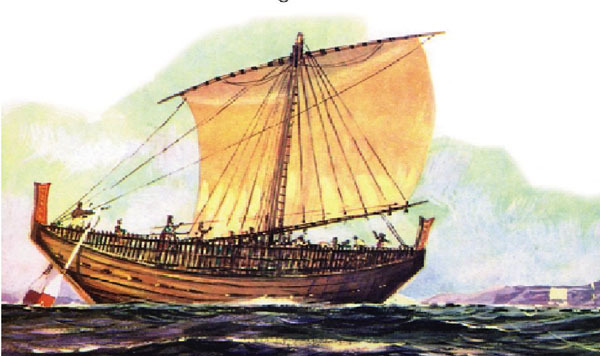
Celtic ships brought stories of strange and exotic creatures.
Allied to this was a fascination with travellers' tails. Although travel was
perhaps more frequent than we suspect in these early times, it was only
certain people who in fact, journeyed any distance. They returned with
wonderful tales of countries which they had seen and explored and of the
wonderful beings that they had seen there.
These stories, tall as they were, were readily accepted as fact in places like Christian Europe and it was
readily believed that astonishing races lived in other lands -- men who looked
curious and who behaved in a curious fashion. Amongst these descriptions
was that of a dog-headed race of men who lived somewhere in the East --
some of whom were primitive and others who were relatively advanced.
Stories of the "dog-heads" readily fell into the perceptions of the man-wolf in
popular imagination and it was thought that if these people mated amongst
human kind they might produce offspring who could alternate shape at will.
There was one other element in the cultural and imaginative mix concerning
werewolves -- cannibalism.
It has been suggested that cannibalism was
probably much more widespread in earlier societies than we care to
acknowledge, particularly in remote areas of the developing world. In remote
areas during harsh seasons, poverty-stricken individuals may well have
resorted to eating each other in order to survive.
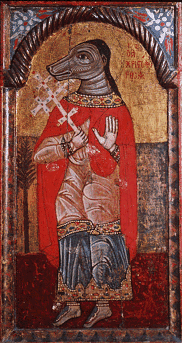 [Left:] Saint Christopher
In the Eastern Orthodox Church, certain icons covertly identify Saint Christopher with the head of a dog. The background to the dog-headed Christopher is laid in the reign of the Emperor Diocletian, when a man named Reprebus, Rebrebus or Reprobus (the "reprobate" or "scoundrel") was captured in combat against tribes dwelling to the west of Egypt in Cyrenaica. To the unit of soldiers, according to the hagiographic narrative, was assigned the name numerus Marmaritarum or "Unit of the Marmaritae", which suggests an otherwise-unidentified "Marmaritae" (perhaps the same as the Marmaricae Berber tribe of Cyrenaica). He was reported to be of enormous size, with the head of a dog instead of a man, apparently a characteristic of the Marmaritae. [Left:] Saint Christopher
In the Eastern Orthodox Church, certain icons covertly identify Saint Christopher with the head of a dog. The background to the dog-headed Christopher is laid in the reign of the Emperor Diocletian, when a man named Reprebus, Rebrebus or Reprobus (the "reprobate" or "scoundrel") was captured in combat against tribes dwelling to the west of Egypt in Cyrenaica. To the unit of soldiers, according to the hagiographic narrative, was assigned the name numerus Marmaritarum or "Unit of the Marmaritae", which suggests an otherwise-unidentified "Marmaritae" (perhaps the same as the Marmaricae Berber tribe of Cyrenaica). He was reported to be of enormous size, with the head of a dog instead of a man, apparently a characteristic of the Marmaritae.
The German bishop and poet Walter of Speyer portrayed St. Christopher as a giant of a cynocephalic species in the land of the Chananeans (the "canines" of Canaan in the New Testament) who ate human flesh and barked. Eventually, Christopher met the Christ child, regretted his former behavior, and received baptism. He, too, was rewarded with a human appearance, whereupon he devoted his life to Christian service and became an athlete of God, one of the soldier-saints. --Wikipedia
|
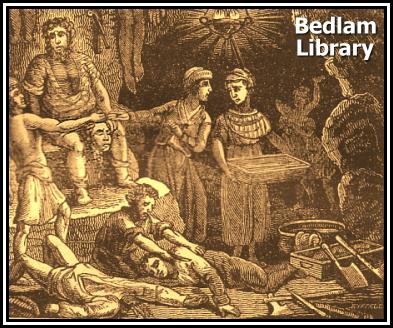
Alexander "Sawney" Bean(e) was the legendary head of a 48-member clan in 15th- or 16th-century Scotland, reportedly executed for the mass murder and cannibalization of over 1,000 people.
From time to time tales of
cannibals surfaced into mainstream folklore -- the tale of Sawney Bean, "the
Man-Eater of Midlothian" in Scotland for instance during the 14th or 15th
centuries (it is not clear however, that Bean existed in the way that the legends
say that he did).
The idea of individuals using their fellow humans for food
and even hunting them down, held overtones of the wild wolves of the forest
and, as some of these individuals lived in remote areas, the connection
seemed all the more obvious. It was not hard then to imagine that the human
predators transformed themselves into their animal counterparts, perhaps by
diabolical means.
As Christianity began to assert itself in the West, the idea of the man-wolf
took on a slightly different aspect. Now this creature was the agent of the
Devil and it was the Enemy of All Mankind who gave him or her their
powers. The victim of the werewolf then became the Godly or the innocent --
the old woman living alone or the small child. These themes were central to
many of the werewolf trials, particularly in France in the 16th century -- Giles
Garnier, the Hermit of Dole, the Werewolves of Poligny, Jacques Roulet. Some of these alleged occurrences were brought about by the Devil, others were
accidental in which the moon (a pagan symbol) played a part.
And so it has continued down to the present -- the idea of the man-wolf (a
figure from many cultures) appearing in literature and film. Although it has
perhaps never enjoyed as much fame as the vampire or Frankenstein, the
prowling beast still lurks somewhere in the depths of the human psyche, a
potent reminder perhaps that we are not as cultured or civilised as we often
profess to be.
ViewZone Magazine || Comments? |
